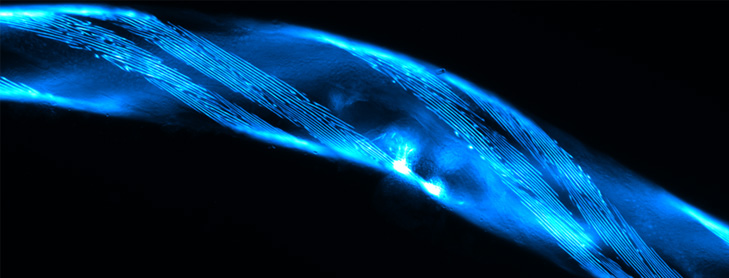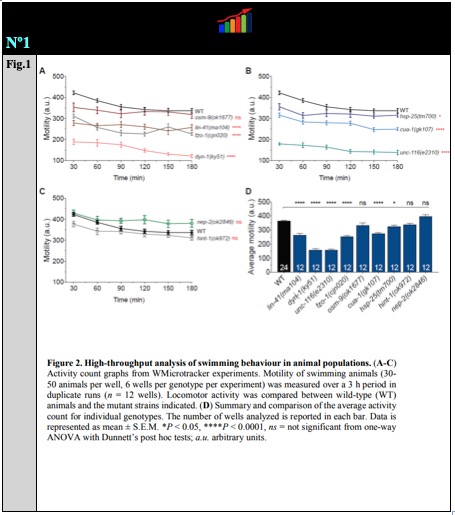
Charcot-Marie-Tooth (CMT) disease is an inherited peripheral motor and sensory neuropathy. The disease is divided into demyelinating (CMT1) and axonal (CMT2) neuropathies. In order to understand the biological importance of CMT2-casuative genes, we have studied the behavioural, cellular and molecular consequences of mutating nine different genes associated with CMT2 in the nematode Caenorhabditis elegans (lin-41/TRIM2, dyn-1/DMN2, unc-116/KIF5A, fzo-1/MFN2, osm-9/TRPV4, cua-1/ATP7A, hsp-25/HSPB1, hint-1/HINT1, and nep-2/MME). We show that C. elegans defective for these genes display debilitated movement in crawling and swimming assays.
Materials And Methods:
We recorded the motility of 30-50 worms/well from each group (6 wells per genotype per experiment in 96 well plates) for three hours using an automated movement detection instrument (WMicrotracker). To obtain large numbers of synchronized, gravid adults were first bleached to release the eggs, which were incubated overnight for hatching. Hatched L1 worms were then plated the next day and left to grow until they reached adulthood. We instead manually separated adult worms from their progeny until they reached the 3-day old adult stage for WMicrotracker experiments. The separation was
achieved by washing the plate containing adult worms and progenies into a tube and letting the adult worms precipitate by gravity. The synchronized A3 worms were then plated into a 96-well plate (at least 6 wells per group per experiment) and movement measured with the WMicrotracker instrument.
From the WMicrotracker screens, the wild-type populations of worms started with a motility count of about 420 arbitrary units (au), but slowly became less motile, reaching a plateau of around 330 au over the final hour of analysis (Fig. 2A-C). The average motility of wild-type worms during the 3-hour experiments was 365 au (Fig. 2D). In stark contrast, both dyn-1(ky51) and unc-116(e2310) mutants consistently recorded motility counts below 200 au (Fig. 2A, B,D). Populations of lin-41(ma104), fzo-1(cjn020) and cua-1(gk107) animals also experienced significantly reduced movement, registering between 220 and 330 au throughout the experiments (Fig. 2A, B, D). Worms lacking hsp-25 had a slight (~12%), but statistically significant reduction in motility, whereas mutation of osm-9, hint-1 or nep-2 had no effect on movement (Fig. 2A-D). These automated, time-effective WMicrotracker assays could prove highly advantageous for drug screening approaches to identify compounds that are able to reverse the movement defects in these animals.

…………………………………………………………………………………………………………………………..
bioRxiv preprint first posted online Apr. 11, 2019.
https://doi.org/10.1101/605584
https://www.biorxiv.org/content/10.1101/605584v1
Ming S. Soh, Xinran Cheng, Jie Liu, Brent Neumann
*Worm Image source: https://www.neumannlab.com/charcot-marie-tooth-disease-and-mfn2.html
